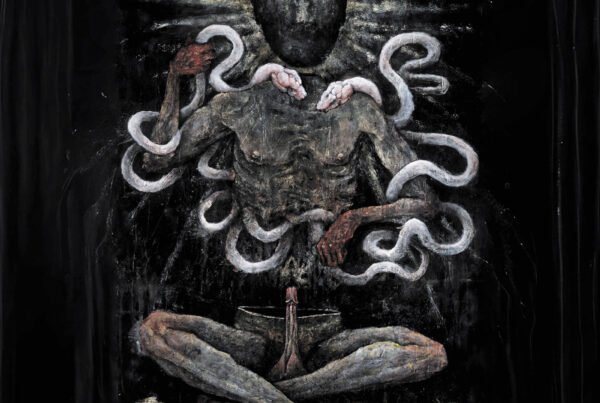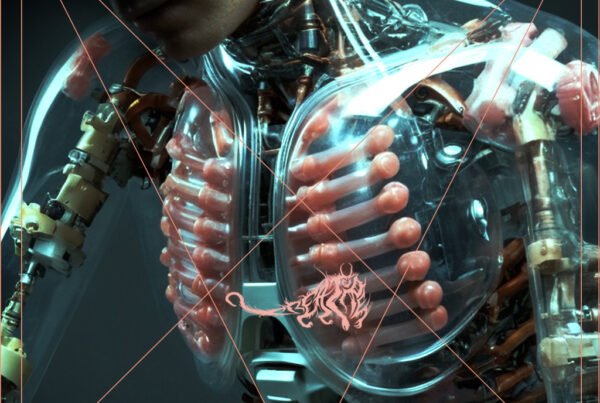Belgium’s Neptunian Maximalism (NNMM) seem to possess a massive presence through every aspect of their sound, vison, and aesthetics, allowing this project to thoroughly explore and rectify the essence of human nature in its modern form through sonic means of artistic expression. This project is the brainchild of multi-instrumentalist and accomplished painter/graphic designer/label runner (Homo Sensibillis Sounds) Guillaume Cazalet, who conceived NNMM back in 2018, recruiting a full line-up (including saxophonist Jean-Jacques Duerinckx and percussionists Sebastien Schmit and Pierre Arese) and subsequently releasing their first mini-album The Conference of Stars in the same year.
I first was introduced to NNMM after the release of the collective’s first full-length release Eons in 2020. This album trilogy, concerned with exploring the evolution of the human species from the anthropocene era to the ‘probocene’ era where intelligent elephants rule superior, was where I was introduced to a wide sonic palate of transportive sounds induced by a blend of drone metal, free jazz and cosmic psychedelia that explored the outer limits of human nature and its correlation with the complex systems of our universe. Now, Cazalet seems to be pursuing this inter-cosmic journey that pushes the boundaries of sonic comprehension with another album trilogy, Le Sacre Du Soleil Invaincu, which continues this transcendental experience with new musical ideas; in particular, the use of traditional Indian Raga music that elevates the raw spiritualism that resembles NNMM’s core essence.
The first part of this trilogy, “At Dusk: Raag Marwa”, commences this spiritual immersion into a transformative realm of psychedelic oblivion. The low rumbling at the beginning of “Alaap” sets a calming presence for the first few minutes before a sudden dynamic shift is revealed through NNMM’s signature drone metal sound. As the sound progress, very much in this Sunn 0)))-like fashion, the instrumentation starts to slowly develop, introducing a teaser of these Indian classical traits within the string sections. “Vilambit Laya Alaap” and “Unisson Composition” continue to add depth and texture in the form of brash and dramatic soundscapes in an attempt to elevate the listener into the spiritual reality. The harsher aspects of the music, like the distorted guitars and abrasive layers of noise, blend quite well with the more folk-like elements that are starting to creep in, particularly the vocal chants that take effect at the end of the third track. A constant negotiation of dynamics tends to come into focus a lot for this first part, the piercing whistle of feedback that links the third track to “Dream Chord” pushes the record’s hypnotic narrative into full swing. The space like textures of this elapsing track create a sci-fi impression with heavy emphasis on analogue synthesis that gives serious Vangelis – Blade Runner vibes.
Introducing us to the next part in the trilogy, “Arcana XX: Raag Todi” (and “Raag Raudra Todi”) is a series of improvised sitar passages that act as the core part of this section. The rawness of these spiritual ragas is incredibly powerful and brings an all-rising sense of transcendentalism, looking to take the listener out of their body and into this sonic universe NNMM endlessly carved out. “Alaap On Surbahar” is the first to express these Indian classical elements in a tense and sometimes chaotic manner; the improvised passages ring out in slower and slower succession and gradually distinguish in their tonal qualities, honouring the hypnotic allure of the drone. To accompany these folk instrumentals is the harsh and heavy metallic wall of noise that comes from several layers of guitar feedback and intensified polyphonic percussion on “Drut Laya”. The repetitive movements increase in their chaotic approach and give an unnerving sense of anxiety and sonic distress. Many space-like progressions soon start to develop near the end of this track and give more of a krautrock feel to them. “Madhyalaya DCCLXXII” takes a while to really achieve what the artists are going for here, as it first seems like a series of sounds pushed together in a deliberately disorderly fashion, yet once you become fully immersed in these spaces, you begin to almost comprehend them as a piece of a more complex puzzle that finds its rhythmic voicing by the final part of the track. One way that one could appreciate this track is by listening to it as a musical conversation between the players, one which goes from them finding their footing to soon gaining a strong sonic connection as time progresses.
The final part, “At Dawn Raag Bairagi” contains some moments that emphasise the conventions of psychedelia and atmosphere through spacey wah-pedal guitars and crescendoing soundscapes. The overdriven guitars produce a cacophony of feedback and reversing loops, surrounding the breathtaking vocal chants that conjure a ritualistic sense of catharsis. The merging atmospheres and rising textures feel like one final trip that sends the listener soaring into the bleakest depths of a black hole. This section seems somewhat like the most conventional in terms of instrumentation and style, as it leans more in the direction of doom metal and space rock. By no means does this exempt this section from being the weakest of the three; contrarily, this only prepares the listener for the final chapter of this massive sonic experience. “Layakari in Offer To The Cosmic Serpent” is like the space-folk-opera closer that ties the entire record together. Beginning with the ritualistic wind and percussive sounds, this is then followed by a tense and fast-paced series of repetitive melodic phrases all in the Indian classical tradition before unleashing into a barrage of dense, hypnotic drones.
Neptunium Maximalism once again hit their stride with an ambitious, impactfully dense and operatic soundtrack into a spiritual oblivion that utilises their trademark stylings of drones, psychedelia, krautrock, and free jazz. Not only does this record demonstrate NNMM’s strongest traits in full swing, but the heavy influence of Indian classical and folk instrumentation further enhances the meditative and airy sensations that are ever present. As far as experimentation and abstract musical interpretation goes Neptunian Maximalism constantly operate on the fringes of sonic expression and Le Sacre Du Soleil Invaincu conceivably becomes a formidable release that will take this musical collective forward for time to come.






